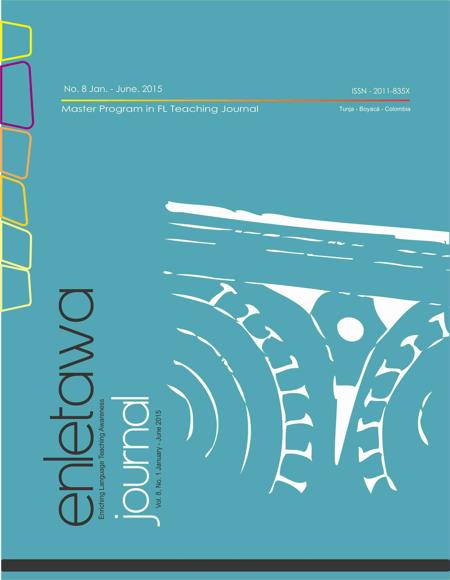The Collaborative Portfolio: Exploring Reading Skills Through Peer Tutoring

Resumen
Our research emerges as an alternative to adopt the use of portfolios in EFL
Licenciatura programs. As tutors in a peertutoring university project, we explored
tutees´ English reading skills as they used a collaborative portfolio with us, their tutors,
during their free time. As a result of this research, we determined that the portfolio
emerged as a “planner for tutees’ reading skills”, allowing themto establish objectives
for boosting their comprehensive skills. Furthermore, the portfolio became an
“enhancer of collaborative roles” between tutees and tutors. Finally, the portfolio
allowed tutees to explore their own reading skills by supplying them with reading
experiences.
Citas
- Álvarez, G. M. (2004). Manual de tutoría universitaria. Barcelona: Octaedro.
- Ariza, A., & Viáfara G. J. J. (2009). Interweaving autonomous learning and peer-tutoring in coaching EFL studentteachers. Profile Issues in Teachers Professional Development, 11(2), 85-104.
- Beasley, C. J. (1997). Students as teachers: the benefits of peer tutoring. Perth, Curtin University of Technology.
- Castro, L. (2002). El portafolio de enseñanza como herramienta y texto para la reflexión pedagógica. Revista Perspectiva Educativa,
- , 9-17.
- Cristancho, A. M. (2003). La evaluación por portafolio, una estrategia para modelar la responsabilidad personal. Psicología desde el Caribe: Revista del Programa de Piscología de la Universidad del Norte,
- (11), 94-106.
- Cook, V. (1993). Linguistics and second language Acquisition. London: Macmillan.
- Dick, B. (1992). Qualitative action research: improving the rigour and economy. In Proceedings of the Second World Congress on Action Learning (pp. 432-435). Brisbane: University of Queensland.
- Emerson, R. M., Fretz, R. I., & Shaw, L. L. (2011). Writing ethnographic fieldnotes. University of Chicago Press.
- Erten, Ý. H., & Williams, M. (2008). A comparative look into how to measure the effectiveness of vocabulary learning strategies: Through using percentages or correlation coefficients. Journal of
- Language and Linguistic Studies, 4(2), 56-72.
- Feathers, K. M. (2004). Reading and Learning. Pippin Publishing Corporation, p. 108.
- Gardner, R. C. (1979). Social psychology and second language learning: The role of attitudes and motivation. London: Edward
- Arnold.
- Goodman, K. S. (1967). Reading: A psycholinguistic guessing game. Literacy Research and Instruction, 6(4), 126-135.
- Klenowski, V. (2000). Developing portfolios for learning and assessment: Processes and principles. New York: Routledge.
- Mynard, J., & Almarzouqi, I. (2006). Investigating peer tutoring. Elt Journal, 60 (1), 13-22.
- Oktay, J. S. (2012). Grounded theory. Oxford University Press.
- Pugh, A. (1978). Silent reading. London: Heinemann Educational.
- Rodríguez, S. (2004). Manual de tutorial universitaria. Recursos para la acción. Barcelona: Ediciones Octaedro.
- Stevens, D. & Cooper, J. (2009). Journal keeping. How to use reflective journals for effective teaching and learning, professional insight and positive change.
- Virginia: Stylus Publishing. Valls, G. (2008). Una aproximación al
- concepto de portafolio del alumnado. Aula de Innovación educativa, 15 (169), 34-38.
- VelandiaMoncada, D.A. (2007). Tutorial Plan to Support the English Speaking Skill of an Inga Student of an Initial Teacher
- Education Program. Profile Issues in Teachers Professional Development, (8), 121-130.
- Viáfara, J. J. & Ariza, J. A. (2009). Un modelo tutorial entre compañeros como apoyo al aprendizaje autónomo del inglés. Íkala, 13
- (1), 173-210.
- Viáfara, J., & López, M. (2011). Portfolios across the EFLCurriculum:Methodological Perspectives of their use in University
- Settings. Colombian Applied Linguistics Journal, 13 (2), 114-129.
Descargas
Los datos de descargas todavía no están disponibles.